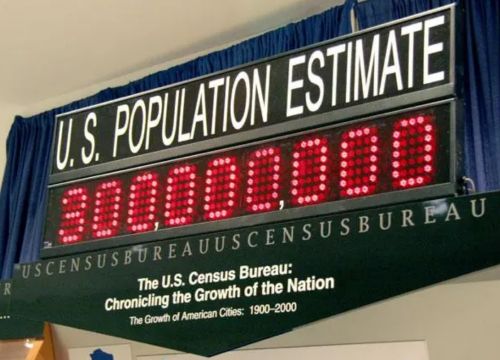

The challenge ahead is learning to adapt to a slower pace, to economies and societies shaped not by expansion but by adjustment.

By Matthew A. McIntosh
Public Historian
Brewminate
A Future of Fewer Births
For decades, the story of humanity has been one of relentless expansion. From the mid-twentieth century onward, rising birth rates and longer lifespans pushed the global population from 2.5 billion in 1950 to more than 8 billion today. That trajectory is changing. New projections show that both the United States and the world are heading toward an era of slower, perhaps stagnant, population growth.
The Congressional Budget Office now estimates that U.S. population growth will slow dramatically in the coming decades, driven by declining fertility, aging demographics, and shifting migration patterns (CBO Report). This slowdown mirrors broader global trends. According to the Council on Foreign Relations, fertility rates are falling nearly everywhere, from Europe to East Asia, creating ripple effects that touch labor markets, healthcare, and geopolitics.
America’s Shrinking Momentum
The United States has long been an outlier among wealthy nations, its population buoyed by higher fertility and robust immigration. That advantage is waning. The CBO projects that by the middle of the century, population growth will slow to a crawl, with fertility rates staying well below the replacement level of 2.1 children per woman.
This shift carries profound consequences. Fewer workers mean slower economic expansion, heavier burdens on younger generations to fund social programs, and growing political fights over immigration as one of the only remaining levers to sustain population. Already, debates over labor shortages and entitlement reform are being reframed through the lens of demographics rather than economics alone.
The Global Picture
The United States is not alone in confronting this new reality. China’s population has already begun to contract, a historic reversal after decades of growth. Japan’s long decline continues, reshaping its society into one of the oldest in the world. Even India, which recently surpassed China as the most populous nation, is projected to peak mid-century before entering decline.
In Europe, shrinking populations are forcing governments to rethink pension systems and labor policies. In sub-Saharan Africa, by contrast, populations continue to grow rapidly, though even there fertility rates are falling. The world is entering a demographic divide: some regions struggle with too many young people and too few jobs, while others grapple with too many elderly and too few caregivers.
Economic Implications
Population growth has always been tied to economic dynamism. More workers mean more productivity, more consumers, more tax revenue. When growth slows, the arithmetic of prosperity changes.
In the United States, industries dependent on young workers (construction, hospitality, healthcare) face looming shortages. Automation offers partial relief but cannot fully replace human labor. The tax base narrows while the demand for social spending expands, particularly as the elderly population swells.
Globally, slower growth raises questions about innovation and demand. Will consumer markets shrink? Will economic growth stall in aging nations while younger countries surge ahead? The answers may determine the balance of global power in the twenty-first century.
Republicans and the Politics of Population
For some Republicans, the conversation about declining fertility has become ammunition in the fight against abortion rights. Conservative attorneys general and lawmakers increasingly argue that slowing population growth is reason enough to restrict access to abortion pills and limit reproductive freedom. As MSNBC reported, GOP officials frame population loss as a national crisis, claiming that “every birth counts” in maintaining America’s economic strength and cultural vitality.
This framing recasts abortion not as a matter of private choice but as a demographic threat. It turns declining fertility into a political talking point, woven into the broader culture war. By linking reproductive rights to population decline, Republicans seek to portray abortion as both morally unacceptable and economically reckless.
The argument, however, brushes past the complexities of why people are having fewer children. Housing costs, healthcare burdens, childcare shortages, and stagnant wages all play roles in shaping decisions about family size. Casting abortion restrictions as a solution to demographic decline oversimplifies a problem rooted in structural inequality. For many women, it reads less as concern for the future and more as another attempt to police reproductive autonomy.
Cultural Shifts and Human Choices
Behind the numbers lie personal decisions. Couples in wealthy nations are choosing to have fewer children, often citing economic pressures, climate anxiety, or simply a preference for different lifestyles. In many places, women’s increased access to education and employment has reshaped family planning.
In the United States, younger generations are marrying later, if at all, and weighing the costs of childcare against stagnant wages. These are not trends easily reversed by policy incentives like tax credits or parental leave, though such measures may help. The slowdown is not only a statistical reality but a cultural one, woven into how people imagine their futures.
A World Rebalanced
The implications of slower population growth extend beyond economics and culture. They touch geopolitics. Nations with shrinking populations may see their military strength wane, their global influence diminish. At the same time, migration pressures may intensify as younger populations in Africa and South Asia look outward for opportunities.
This rebalancing could alter alliances and rivalries. Aging powers like the U.S., Europe, and East Asia may find themselves competing for migrants to replenish workforces, even as political resistance to immigration remains strong. Demography, once treated as background, is emerging as a driver of history.
Conclusion: Preparing for the Plateau
The era of explosive population growth is ending. The challenge ahead is learning to adapt to a slower pace, to economies and societies shaped not by expansion but by adjustment.
For the United States, this means confronting hard questions about immigration, healthcare, and social security. For the world, it means accepting that the twentieth century’s demographic boom was an anomaly, not a permanent condition. The future will not be defined by endless growth but by how nations manage the consequences of its absence.
Originally published by Brewminate, 09.17.2025, under the terms of a Creative Commons Attribution-NonCommercial-NoDerivatives 4.0 International license.


